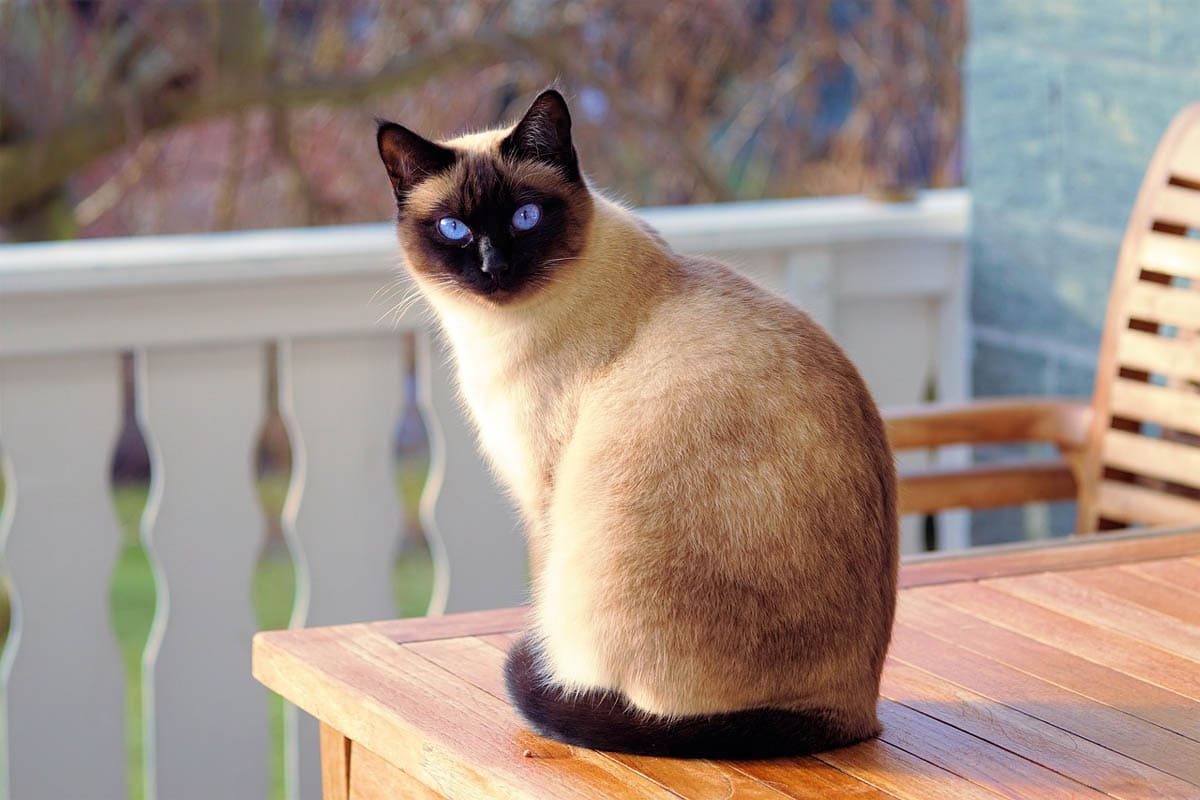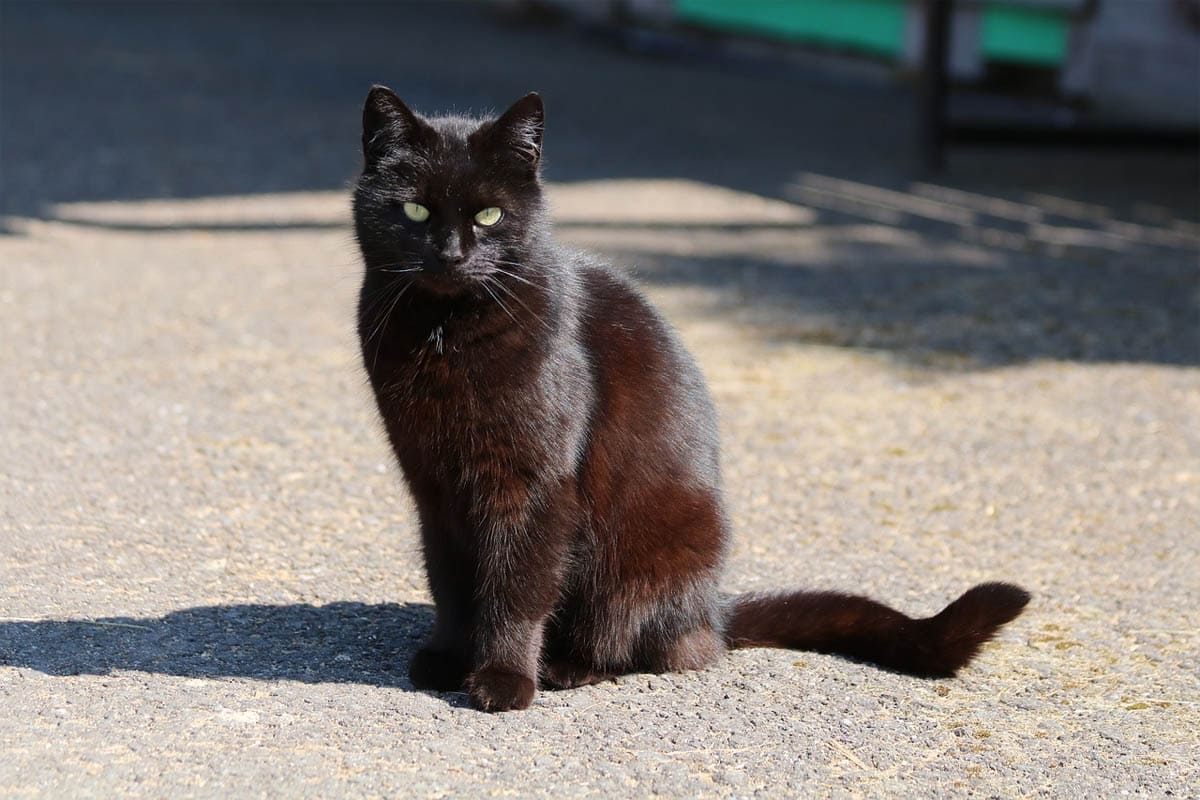Genetics may determine the basic color of the cat, but other factors can affect the intensity or variation of the color. These factors can be environmentally determined, as in the area we are about to discuss.
Some interesting results were found from experiments regarding feline dietary tyrosine nutritional requirements and the effect on a black cat’s coat color. Diets deficient in tyrosine caused the cat’s hair to change from black to reddish-brown due to a reduction in melanin in the hair.
What is tyrosine?

Tyrosine is an amino acid that the cat synthesizes from phenylalanine (another amino acid). Amino acids are the building blocks of protein. Tyrosine is necessary to make melanin, the major pigment in cats skin and hair; it gives us beautiful colors. If you can’t make tyrosine because you are missing the correct enzyme, you don’t produce as much melanin.
Albinos cannot produce melanin, and you end up with the pale skin and hair of the albino. Overactivity of the enzyme can have the opposite effect, with large areas of highly pigmented skin/hair or nasty tumors on the skin (melanomas).
Tyrosinase is the action of the enzyme tyrosine on melanin, which causes a complex series of biochemical changes. Tyrosinase is also thermally liable (temperature-sensitive).
A quick side note:

Cats of the Himalayan series (color points, minks, and sepias) have heat-sensitive tyrosinase. Normal tyrosinase converts the amino acid tyrosine into melanin (pigment). In Himalayan cats with this enzyme, the color forms only on the colder extremities of the body (legs, tail, ears, face). This is why Siamese cats get darker in winter and paler in summer. If you put socks on your Siamese for several weeks, it would have white markings on its feet. The complete pigmentation allele for the cat is (C/-). The Burmese cat or sepia cat allele (cb/cb) has slightly thermo-liable tyrosinase, and the mink cat or Tonkinese allele (cb/cs) has somewhat more thermo-liable tyrosinase, and the color point or Siamese (cs/cs) has, even more, thermo-liable tyrosinase.
True albino cats lack the enzyme: the blue eye white albino cat (ca/ca) and the pink or red-eyed white Albino cat (c/c). All these alleles are found on the same locus, interacting with the enzyme tyrosine. Lack of the enzyme tyrosine is also related to the grey hair both humans and cats get as we age.
The experiments
The current recommended feline dietary concentration is 4.5 g tyrosine plus 12 g phenylalanine/kg amino acids for growing kittens to ensure maximum growth rates and nutritional balance in the kitten’s diet. However, several experiments have shown that it is insufficient to retain a black cat’s coat color.
Results from the studies with cats fed diets with the above aromatic amino acid quantities, and lower show that these levels are insufficient to maintain a black cat’s coat. Black cats on diets deficient in phenylalanine + tyrosine found that their lovely black coat color changed to a reddish-brown. This was due to a reduction in the melanin (pigment) in the hair and a decreased total melanin concentrations of tyrosine in plasma. Reddish hair color or rusting was induced in cats fed tyrosine-deficient diets for six months and in black kittens born to queens fed tyrosine-deficient diets during their pregnancy.
Maintaining the black coat color:
The cat and kittens’ black hair color was maintained or restored by diets containing a high tyrosine concentration. Cats fed diets with “..<16 g phenylalanine + tyrosine developed ‘red hair.‘
We confirmed anecdotal reports that the black hair of cats can change from black to reddish-brown. An aromatic amino acid concentration > or =18 g/kg is recommended to prevent visually discernible red hair in black-coated cats. Dietary concentrations >18 g total aromatic amino acids/kg diet promote a more excellent ratio of PTCA: total melanin in the hair. ” (Anderson et al., July 2002). Cats needed to ingest more than 18g per kg of phenylalanine + tyrosine to maintain or restore a black cat or kittens rich coat color.
Levels less than 16g resulted in reddish hair color on the black cat.
Not mentioned in these studies is what happens when a cat ingests too much tyrosine. Anecdotal evidence suggests that the cat’s coat will darken more than it should (e.g., a chocolate cat may become almost black).
Other factors
Without going into too much detail on the complex relationship between the cat’s organs, vitamins, and amino acids, below are just a few factors that could be affecting melanin.
Copper deficiency:
One of the early signs of copper deficiency in cats is a loss of hair color (achromotrichia) and a change in the texture. The reason for the color change is an alteration in tyrosine metabolism. Copper helps tyrosine work as a pigment factor.
Zinc excess:
Too much zinc in the diet may cause a copper deficiency, which, in turn, can cause an iron deficiency. As a result of the copper deficiency, you end up with the above.
Thyroid, kidneys, and liver:
These three organs can also affect coat color and interact with tyrosine. The liver metabolizes tyrosine, which is necessary for synthesizing thyroxin, a hormone produced by the thyroid glands.
Should I just give my cat tyrosine if its coat is turning reddish?
Before you rush out and start adding things to your cat’s diet, please check with your veterinarian first. Many other factors can influence a cat’s coloring. Never supplement your cat’s diet without consultation with your veterinarian.
What you can do:
Feed a high-quality diet with meat as the main ingredient. Learn how to read pet food labels and always check the ingredients panel. Look for cat food that lists meat as the first ingredient.
Contraindications:
- Cats with liver, kidney, or thyroid disease
- Pregnant cats
- Cats with a malignant melanoma
- Any cat has a serious illness or is on medication
Always consult with your veterinarian before giving your cat any supplements.
What does it mean when your cat’s fur changes color?
Due to melanin’s part in determining fur color, a change can indicate a hormonal imbalance or tyrosine deficiency.
Additionally, your cat’s temperature or age can significantly affect its fur color.
Can a brown cat turn black?
Brown cats are among the rarest colors, with “true chocolate” being recognized in only the Havana Brown cat breed.
Brown cats can turn black if their diet is too rich in tyrosine, producing extra melanin. The presence of excess melanin can darken the fur color.
What is rusting?
Rusting is a condition in which the coat of a black cat turns reddish/brown. It results from changes in the level of tyrosine, which affects the development of melanin.
Key points
- Rusting is a condition in which the coat of a black cat turns reddish/brown.
- Tyrosine is an amino acid necessary for melanin, a pigment in the skin and hair of cats.
- The recommended feline dietary concentration is 4.5 g tyrosine for optimal growth.
- Experiments showed that these levels were insufficient to maintain a black coat. An aromatic amino acid concentration > or =18 g/kg is recommended to prevent visually discernible red hair in black-coated cats.
- Animal products, such as meat and fish, contain tyrosine.
Frequently Asked Questions (FAQs)
Can a cat’s fur pattern change?
Tabby cats have stripes, and the patterns move over their body and reset. Cats with spots or frosted tips can change too. This happens because tabby is a coat pattern, not a breed. As tabbies grow, it’s common for their markings to darken or become more prominent.
Do all black cats turn brown in the sun?
Not all. Whether your black cat turns brown in the sun is determined by temperature, tyrosine, and age. Additionally, some black cats look brown in the sun due to underlying tabby patterns.
Do cats change color as they get older?
A cat can change color as they get older. Younger cats become darker as they transition to adulthood. Senior cats turn gray.
References:
“Red hair in black cats is reversed by adding tyrosine to the diet. “MorrisJG, Yu S, Rogers QR. Department of Molecular Biosciences, School of Veterinary Medicine, University of California, Davis, CA, USA. Cats J Small Anim Pract 2001 Apr;42(4):176-80
“Effect of low levels of dietary tyrosine on the hair colour of cats.” Yu S, Rogers QR, Morris JG. Department of Molecular Biosciences, School of Veterinary Medicine, University of California, Davis 95616, USA. J Nutr 2002 Jul;132(7):2037-42 Cats require more dietary phenylalanine or tyrosine for melanin deposition in hair than for maximal growth.
“Sensory Neuropathy in Cats maintained on Phenyl-Alanine/Tyrosine Deficient Diets”. P.J. Dickinson, P. Anderson, D.C. Williams, L.D. Tripp, G.D. Shelton, R.A. LeCouteur. School of Veterinary Medicine, University of California, Davis, CA, and University of California-San Diego (Shelton), La Jolla, CA. Various microbiology texts.

